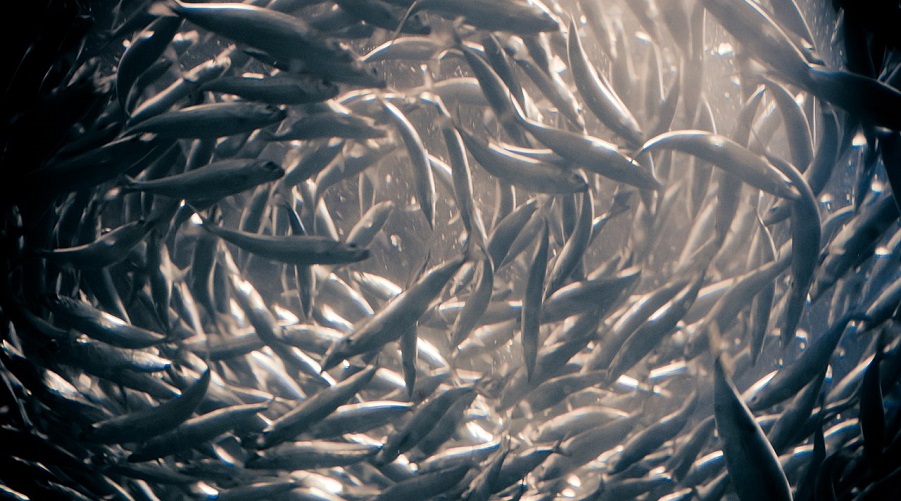
Swirling school of anchovies. Photo by Cliff, Wikimedia Commons.
Over 120 million tonnes of carbon dioxide equivalent could be sequestered every year by 2050 by applying a market-based solution (MBS) to global fisheries that would allow fishers to decide whether – at certain times – it is more profitable to go fish or to remain at port.
In a recent paper published in npj Ocean Sustainability, an international team of researchers shows that the monetary benefits of the MBS could reach $66 billion per year by 2050 if the social cost of carbon dioxide (SC-CO2), which refers to the monetized value of the damages to society caused by each incremental tonne of CO2, is also considered.
The carbon dioxide equivalent or CO2e, on the other hand, is used to compare the emissions from various greenhouse gases by converting amounts of other gases to the equivalent amount of carbon dioxide with the same capacity to intensify global warming.
carbon trading scheme
The market-based solution presented by the researchers proposes immersing global fisheries in a carbon trading scheme. The foundation of such a mechanism is the fact that marine vertebrates – from fish to amphibians – store carbon in the ocean as biomass during their lifetime and transport it from the surface to deeper waters and the seafloor. What they store in weight is known as ‘blue carbon.’ Thus, by putting a price on that blue carbon, allowances are created and fishing rights become a pricey and scarce commodity.
“In other words, when first-sale prices are lower than what it takes to extract the fish, fishing fleets will decide not to go fishing and, instead, trade their carbon allowances in the market,” Raul Prellezo, lead author of the study and a researcher at AZTI, Marine Research, said. “The opposite would also be true. This means that reallocating fishing activities would not have any negative social and/or market impact.”
Using the Sea Around Us database of global marine fisheries catches, Prellezo and his co-authors estimated the scheme’s benefits.
From 2011-2018, industrial and artisanal fisheries extracted an average of 106 million tonnes of marine fish and invertebrates per year from the global ocean, at an estimated ex-vessel value of $222 billion based on a price database created by the Fisheries Economics Research Unit (FERU) and the Sea Around Us, with anchoveta and Alaska pollock as two of the most landed species.
“With these data, we were able to estimate that total landings represent a blue carbon budget of 161 million tonnes of CO2e per year or 1.51 kg of CO2e per landed kilogram of fish. This total is considered the cap or initial allowance, which at the 2022 Emissions Trading System (ETS) prices set by the EU, is equivalent to $11 billion in potential benefits,” said Rashid Sumaila, co-author of the paper and head of the FERU at the University of British Columbia’s Institute for the Oceans and Fisheries. “When the trading scheme is applied, the CO2e sequestered increases, moving from zero if the CO2e trading price is zero, that is, there is no opportunity cost for fishers, to 27 million tonnes of CO2e or 17 per cent of the total CO2e cap per year if 2022 ETS prices are used.”
mILLIONS OF TONNES OF CO2
These calculations allowed the researchers to model a 2050 scenario. Their estimates show that the application of the scheme would result in 122 million tonnes of CO2e sequestered per year or 76 per cent of the CO2e cap, which is equivalent to $66 billion per year in potential benefits when considering the social cost of carbon dioxide.
“The latter also implies that if CO2 trading prices reach the 2050 SC-CO2, around 75 per cent of the landings worldwide would be more valuable as carbon than as foodstuff in the market,” said Maria ‘Deng’ Palomares, co-author of the paper and the Sea Around Us project manager. “This scheme provides the global economy with an alternative for the fisheries sector, which grapples with the complexity of finding options to reallocate invested capital. It also promotes a reduction in overfishing and contributes to building climate resilience and a more equitable distribution of income from the oceans.”
The paper “Building climate resilience, social sustainability and equity in global fisheries” was published in npj Ocean Sustainability https://doi.org/10.1038/s44183-023-00017-7

